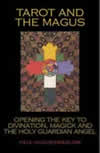|
Tarot Reflections |
March 1, 2004 |
| Review: Tarot and the Magus Valerie Sim, CTGM |
|||||||
|
|
A little over two years ago I asked Mr. Hughes-Barlow if he would become a topic moderator for EDs on my email list, Comparative Tarot, and was delighted when he agreed to do so. Far from a battle, what he encountered on the elist were a lot of intelligent questions and a whole lot of interest in what he had to say about using dignities. It was actually one of the most successful threads we have ever had. The discussion was brought back by popular demand the following year, and although it did not generate as much interest as previously, it was again well received. Since that time I have also seen EDs presented on other lists and websites. Though ED-users often differ on the specifics of the system used, it is obvious that many people in the growing Tarot community are quite receptive to adding dignities to their Tarot repertoire. Further, when people ask where they can learn more on the subject, the author's Super Tarot website (http://www.supertarot.co.uk) is always one of the first sites mentioned as a great resource. Now, onto the book itself. The author begins with the statement that "With hindsight it should have been obvious to all but the most shallow and incompetent magician that a book structured on the Golden Dawn system of Tarot and the number eleven would inevitably result in some kind of magickal or spiritual knowledge." Though not a magician myself, I do find the concept of analyzing a synthesis of the Tarot and the Master Number eleven to be an intriguing premise. Additionally, a thoroughly accessible and modern approach to the Opening of the Key spread (OOTK) is long overdue. Anyone that has waded through the Book of Thoth and other Golden Dawn material should be well aware of the power and complexity of this intricate and multi-layered spread. But though Crowley's writing is deep and broad, it is by no means easy reading. A modern map of the OOTK rich in detail and explained fully is a wonderful idea. And I found this book's intro to the OOTK to be absolutely marvelous. |
||||||
Even if the reader goes no further than Chapter Two's "Overview of Reading the Card" and card pairing they will have a superb window on a reading that can stand alone or proceed into card-counting and the analysis of card triplets. This overview includes an explanation of the following methods of analyzing the spread:
As I read this chapter I found myself mentally creating a little "spread sheet" (pun intended) to facilitate analysis of the OOTK. Having become so inspired, it only took a few minutes to create such a spreadsheet and I found it a handy tool for both the analysis and preservation of the two readings I did at that time using this format. This enabled me to do the basic overview fairly quickly while preserving the readings complete with precise card order so that I could go back and continue with card-counting and in-depth triplet analysis after finishing the book. I also liked the idea Mr. Hughes-Barlow credits to his publisher of beginning each chapter with a commentary on the paired Major cards. Though it is not explained in the book, the author assumes that the reader understands that this pairing is of the first Major to the last one, progressing to the second card with the second to last card, and so on. I enjoy analysis by pairing, by triplets and by many other methods so I found this intriguing. I found I was least interested in the discussion of the paired cards' gematria. I have many metaphysical interests including Tarot, astrology, numerology and shamanism, but I admit that gematria, goetia and enochian magic are not at the top of my list of avid interests. Nevertheless, it was an interesting read that I found intellectually stimulating. Chapter Eight provided me with a chuckle when I read the author's experience with clients who are seemingly unable to follow instructions when it comes to cutting cards. I have noticed the same thing. I was relieved to see that he understood that the specific manner in which such deviation occurs is often quite enlightening in itself. As Tarot readers we find that readings can involve messages from more than one Angel (or Guide, power animal, etc., depending on your viewpoint). Frequently there will be a message for not only the client, but for the reader as well, and all messages deserve our attention. Have you ever noticed how a certain card will appear repeatedly in successive readings that you do for different clients during a certain period of time? When that happens I know that card is shouting at me to pay attention to it personally as well as interpreting it within the readings for my individual clients. In reading Chapter Nine I found myself often nodding yet occasionally frowning. Long on the shamanic path myself and currently writing a book on shamanic Tarot, I heartily enjoyed most parts of this chapter, but felt let down in other spots. I was somewhat surprised to find that like myself the author diverges from the Golden Dawn system in his attributions of elements to the four directions. His assignments are identical to my own as I presented them in Tarot Outside the Box and will elaborate upon them in Shamanic Tarot . Since shamanism exists/existed in many widespread and completely disparate cultures, I also appreciated the fact that the author approached this subject multi-culturally. Most of the overviews were good, howbeit brief, but I would like to have seen the chapter go beyond a simplified introduction to major shamanic concepts and into a presentation of specific ways each concept can be amplified with the Tarot. Though the author has an interesting spin on the Celtic Cross seen via a shamanic lens, I would have liked to have seen more integration of the two subjects. Chapter Ten introduces sex magick into the interpretation. I agree that "every action is a magical action" and that not all "children" of sex magick are named and in possession of a Social Security number. Sex magick can be every bit as much about a mystical union as it is about a physical one. However, unlike Sigmund Freud, I do not see sex as the basis of every message and/or urge. Even in readings concerning love (and yes, we readers are asked to do an awful lot of those!) important messages often have little or nothing to do with sex. Likewise, it is not uncommon to have the cards loudly proclaim that the sex is the only good thing in a relationship that has little else going for it and likely not to last. And I have to admit that in thirty years of reading, I have never "seen" masturbation in the cards. I was a bit surprised that the author uses the Kabbalah spelling rather than the Qabalah favored by many students of the Western Mystery Tradition. This is not a criticism, just an observation. Mr. Hughes-Barlow has obviously studied the Sepher Yetsirah and other Hebrew works on the subject which probably accounts for his spelling choice as opposed to the Qabalah favored by Dion Fortune and other Hermeticists. No one Tarotist has the ultimate and complete picture of Tarot - or anything else for that matter <g>. Read. Study. Meditate. Assimilate. Discard. I think it is a wise approach to read everything you can get your hands on; to sift through it all and then decide what to retain. I do recommend this book as one serious Tarotists should read. I guarantee it will make you think. As with all books, adopt that which motivates or excites you and leave the rest by the wayside. This book is now available from Amazon (both the Canadian and American sites). |
|||||||
|
Subscribe to Tarot Reflections, and receive notification of each update! |
|
Request to be added to the list by sending email to TarotReflections-subscribe@yahoogroups.com! |
All articles remain the
property of their respective authors.
Tarot Reflections is a publication of the American Tarot Association
- Copyright (C) 2004
Questions or Comments? Contact Us.


